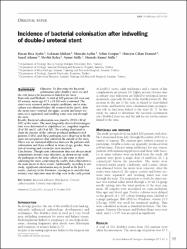Incidence of bacterial colonisation after indwelling of double-J ureteral stent

Göster/
Erişim
info:eu-repo/semantics/openAccessTarih
2015Yazar
Aydın, Hasan Rızaİrkılata, Lokman
Aydın, Mustafa
Görgün, Selim
Demirel, Hüseyin Cihan
Adanur, Şenol
Keleş, Mevlüt
Atilla, Aynur
Atilla, Mustafa Kemal
Üst veri
Tüm öğe kaydını gösterKünye
Aydin, H.R., Irkilata, L., Aydin, M., Gorgun, S., Demirel, H.C., Adanur, S., Keles, M. ve diğerleri (2015). Incidence of bacterial colonisation after indwelling of double-J ureteral stent. Archivio Italiano Di Urologia E Andrologia, 87(4), 291-294. https://doi.org/10.4081/aiua.2015.4.291Özet
Objective: To determine the bacterial colonisation after double-J stent use and the risk factors for bacteriuria linked to the stent. Materials and Methods: A total of 102 patients (61 men and 41 women, mean age 47.5 +/- 14.16) were examined. the stents were removed under aseptic conditions, and a urine culture was obtained before the removal of the stents. After the stents were removed, the upper, central and lower sections were separated, and washing water was sent through the stent. Results: Bacterial colonisation was found in 29.4% (30 of 102) of the stents. the most frequently observed microorganisms were determined as staphylococcus, coagulase negative (8 of 30) and E. coli (5 of 30). the washing fluid used to clean the interior of the catheter produced pathogens in 8 patients (7.8%), and these pathogens were observed to be the same microorganisms that colonised the outside of the stent. There was no statistical difference between the patients with colonisation and those without in terms of age, gender, duration of stenting and reason for stent insertion. Conclusions: Though stent colonisation does not always entail symptomatic urinary tract infections, as shown in our study, the pathogens in the urine culture are the same as those colonising the stent, confirming the reality that colonisation is the main factor in these events. Additionally, according to our study, significant colonisation may be found in the first 3 weeks, contrary to the literature, causing us to consider that urinary tract infections may develop even in the early period.

















